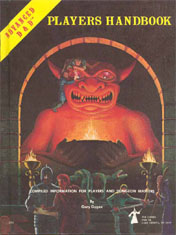 Yesterday’s post about hovering at death’s door got me thinking about AD&D’s system shock rules. In the 1st Edition Player’s Handbook, these rules read:
Yesterday’s post about hovering at death’s door got me thinking about AD&D’s system shock rules. In the 1st Edition Player’s Handbook, these rules read:
System Shock Survival states the percentage chance the character has of surviving the following forms of magical attacks (or simple application of the magic): aging, petrification (including flesh to stone spell!), polymorph any object, polymorph others. Example: The wicked necromancer polymorphs (others) his hireling into a giant roc, with the rather foolish agreement of the changee; the hireling must make a saving throw based on his constitution score using the table above. Assuming he survives, a further saving throw would have to be made if he was again polymorphed or dispelled back to original form. The saving throw must be equal to or less than the percentage shown.
Resurrection survival shows the percentage chance the character has of being successfully raised from the dead or resurrected by a cleric. The score of the percentile dice must be equal to or less than the number shown on the table, or the character fails to be revivified and is completely and totally dead forever. Remember that a character can never be raised from the dead/resurrected a total number of times in excess of the character’s initial constitution score.
Reading through these rules again prompted a couple of thoughts.
First, wouldn’t re-introducing some sort of save-or-die effect for polymorph spells pretty much instantly solve the balance problems those spells have in 3rd Edition? This is a pretty good example of how the long, slow retreat from lethal consequences in D&D can have some really bad tack-on effects when those lethal consequences were serving as an important balancing mechanism.
Second, the degree to which order has been imposed onto the Gygaxian chaos of the early rulebooks. It’s easy to look at big examples (like getting all the numbers pointed in the same direction) and ignore the multitude of smaller adjustments made over the years: For example, 2nd Edition just quietly smoothed away the fact that you have one set of saving throws resolved using a d20-roll-under mechanic determined primarily by class (but adjusted by race and ability score) and a completely different set of saving throws resolved using percentile dice determined by ability score. And even retro-clones like OSRIC follow suit.
Nor, in my opinion, is this something that’s limited to published rulebooks. Gygax was an effusively creative fellow, but his rulebooks are dizzying affairs of the contradictory and the imparsable. I’ve talked before about the fact that the ur-game of D&D basically requires you to impose your will upon the rulebooks in order to play, and I think, when confronted with AD&D, we all tend to quietly gloss over the grosser oddities while sorting everything into a more comprehensible order. And I think that’s true even when we don’t really think about the fact that we’re doing it.
As a final thought, here’s the same set of rules in AD&D2:
System Shock states the percentage chance a character has to survive magical effects that reshape or age his body: petrification (and reversing petrification), polymorph, magical aging, etc. It can also be used to see if the character regains consciousness in particularly difficult situations. For example, an evil mage polymorphs his dim-witted hireling into a crow. The hireling, whose Constitution score is 13, has an 85 percent chance to survive the change. Assuming he survives, he must successfully roll for system shock again when he is changed back to his original form or else he will die.
This may be the perfect example of the shift from AD&D1 to AD&D2: Like most of the rules, this one is essentially unchanged. But in changing a roc into a crow one gets an immediate sense of how AD&D2 rulebooks were turned into vanilla.












